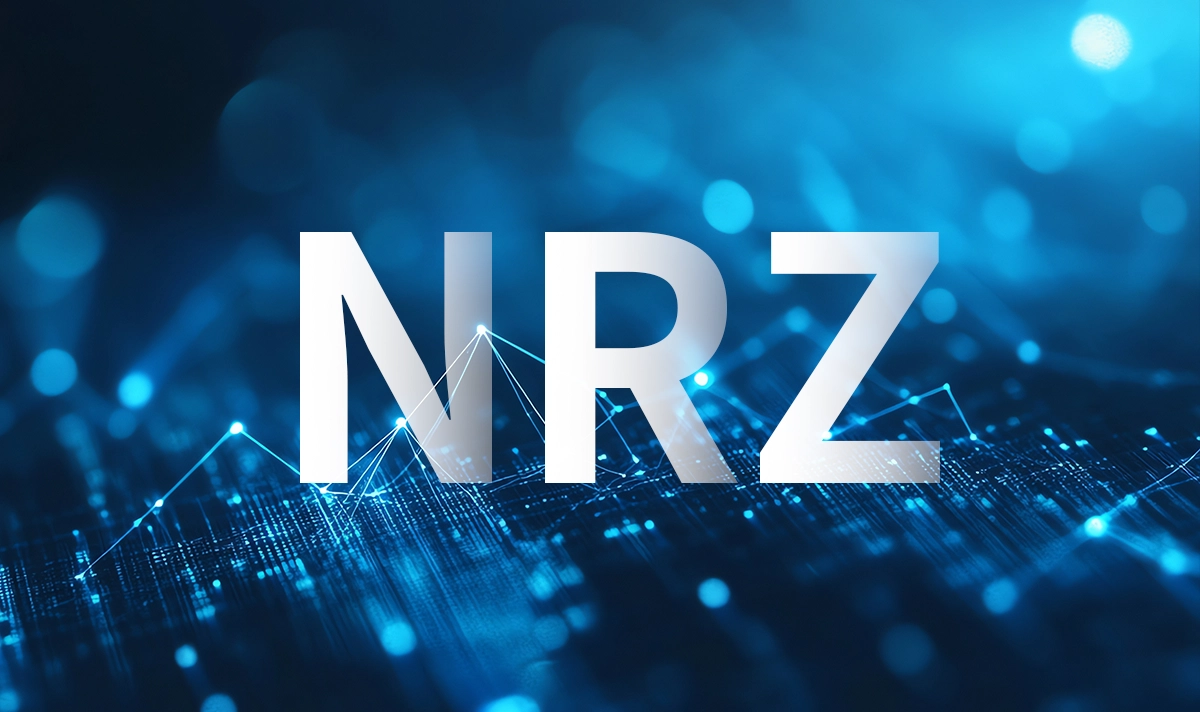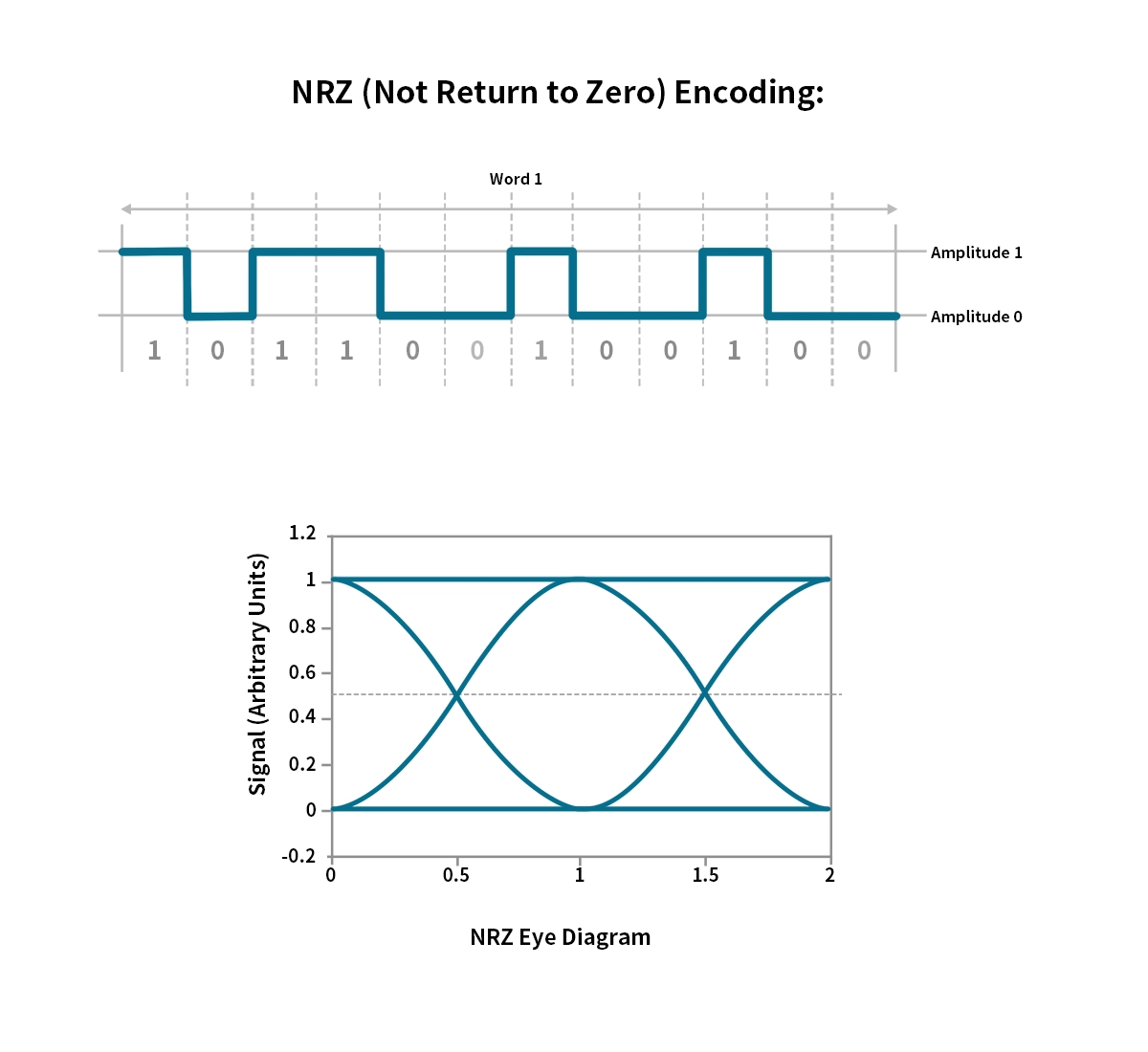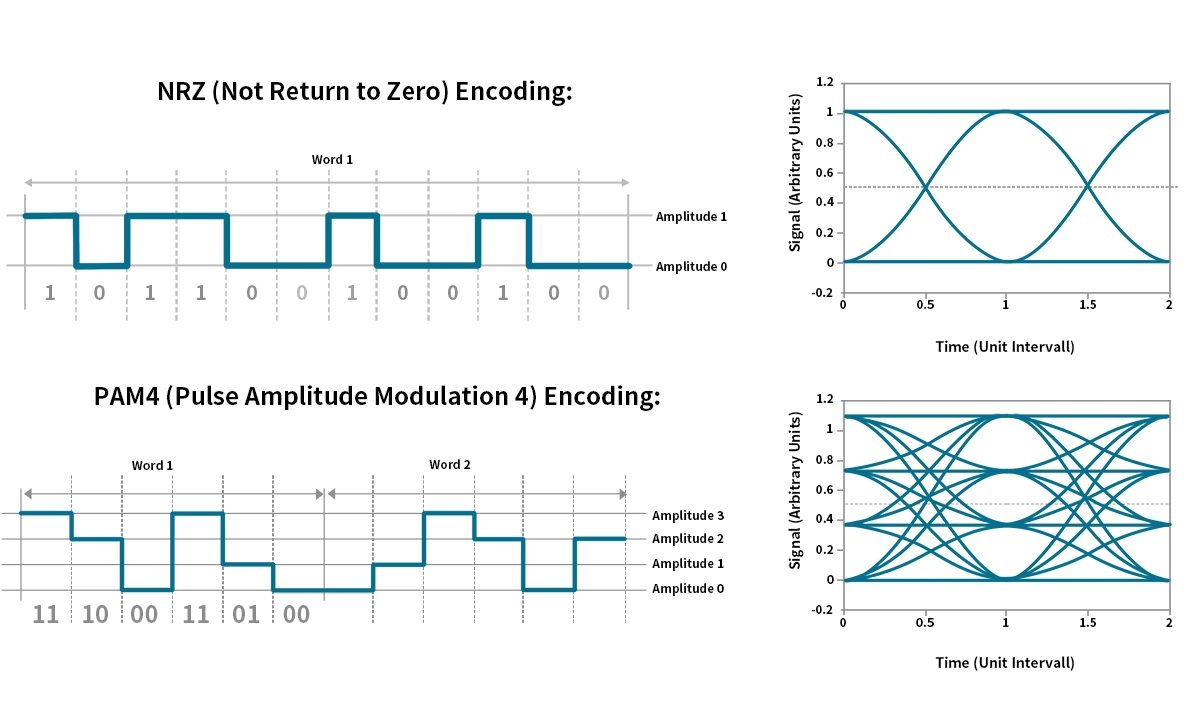
In the high-stakes world of digital communications, where billions of bits traverse continents in milliseconds, the fundamental method of representing those ones and zeros matters immensely. Enter Non-Return-to-Zero (NRZ), a cornerstone modulation scheme that has powered decades of data transmission, particularly within the critical realm of optical transceiver technology. While newer, more complex schemes emerge to handle escalating bandwidth demands, NRZ remains remarkably relevant, offering simplicity, reliability, and cost-effectiveness for numerous applications. Understanding its operation, strengths, and limitations is crucial for anyone designing, deploying, or managing high-speed networks.
➤ Demystifying the NRZ Signal: Simplicity at its Core
Imagine a voltage level representing a digital bit. NRZ encoding adheres to a beautifully simple rule:
Logic '1': Represented by a high voltage level (e.g., +V).
Logic '0': Represented by a low voltage level (e.g., 0V or -V).

The key characteristic lies in its name: Non-Return-to-Zero. Unlike its predecessor, Return-to-Zero (RZ), the signal does not reset to a neutral zero level between consecutive bits of the same value. If two '1's follow each other, the voltage stays high for the entire duration of both bit periods. Similarly, consecutive '0's maintain the low voltage level.
This simplicity translates directly into advantages:
Reduced Bandwidth Requirement: By avoiding the intermediate transitions back to zero, NRZ occupies less spectral bandwidth than RZ for the same data rate. This is highly efficient for optical transceiver designs.
Implementation Simplicity: NRZ transmitters and receivers are generally less complex to design and manufacture compared to more advanced schemes, contributing to lower cost and power consumption – critical factors in large-scale deployments like data centers.
Proven Reliability: Decades of use have refined NRZ technology, making it exceptionally robust and well-understood for many standard applications.
The NRZ Landscape: Variations and Key Concepts
While basic NRZ uses two levels, variations exist:
NRZ-L (NRZ-Level): The standard described above, where the level directly represents the bit value.
NRZ-I (NRZ-Inverted): Also known as Differential NRZ. Here, a transition (either high-to-low or low-to-high) at the start of a bit period represents a '1', while no transition represents a '0'. This offers better immunity to certain types of signal inversion.
➤ Core Challenge: The DC Component and Baseline Wander
NRZ's simplicity comes with inherent trade-offs. The most significant challenge stems from its lack of guaranteed transitions, especially during long sequences of identical bits (long runs of '1's or '0's).
DC Component: A long string of '1's results in a prolonged high voltage, effectively introducing a DC (Direct Current) offset into the signal. Conversely, a long string of '0's creates a prolonged low voltage (potentially negative DC). Many communication systems, especially those using AC coupling (common in receivers to block DC), struggle with significant DC offsets. This can saturate amplifier stages and distort the signal.
Baseline Wander: Related to the DC issue, the receiver uses the average signal level (the baseline) to distinguish between '1's and '0's. During long runs of identical bits, this average level can drift ("wander") significantly. If the drift is too large, the receiver can misinterpret bits, leading to errors. This is particularly problematic at high data rates over long distances using optical transceiver modules.
Clock Recovery Difficulty: Accurate timing (clock) is essential for sampling the signal at the right moment. Clock recovery circuits typically rely on regular signal transitions to synchronize. Long sequences without transitions (long runs of identical bits) make it difficult for the receiver to maintain precise synchronization, increasing the risk of bit errors.
➤ Mitigating NRZ's Limitations: Scrambling and Coding
Engineers haven't abandoned NRZ to these challenges. Clever techniques are employed to make it viable:
Scrambling: Before NRZ encoding, the data stream is passed through a scrambler. This pseudo-randomizes the bit sequence, breaking up long runs of identical bits and significantly reducing the DC component. The receiver uses a matching descrambler to recover the original data. Scrambling is ubiquitous in NRZ-based standards (e.g., Ethernet, Fibre Channel).
Line Coding (e.g., 8b/10b): More structured than scrambling, line coding replaces blocks of data bits (e.g., 8 bits) with slightly longer code words (e.g., 10 bits). These code words are chosen specifically to ensure sufficient transitions (for clock recovery) and maintain DC balance (equal number of '1's and '0's over time). While it adds overhead (e.g., 25% for 8b/10b), it provides guaranteed signal properties. Standards like Gigabit Ethernet (1000BASE-SX/LX) and Fibre Channel rely heavily on 8b/10b encoding combined with NRZ.
➤ NRZ vs. PAM4: The Bandwidth Dilemma
As network speeds push relentlessly towards 400G, 800G, and beyond, the fundamental limits of NRZ become apparent. Doubling the data rate with NRZ essentially requires doubling the signal's bandwidth. However, the physical components – lasers, modulators, photodiodes, and the optical fiber itself – have bandwidth limitations. This is where advanced modulation schemes like PAM4 (Pulse Amplitude Modulation with 4 levels) come into play.

Comparison of Key Modulation Schemes for Optical Transceivers:
Feature | NRZ (PAM2) | PAM4 | Notes |
|---|---|---|---|
Levels | 2 (High, Low) | 4 (3 distinct eyes) | PAM4 packs 2 bits per symbol |
Bits per Symbol | 1 | 2 | Primary PAM4 Advantage: Higher data rate for same symbol rate |
Symbol Rate (Baud) | Equal to Data Rate | Half the Data Rate | PAM4 achieves 2x NRZ data rate at same baud rate, easing bandwidth constraints |
Bandwidth Demand | Higher | Lower (for same DR) | PAM4 is crucial for 400G+ speeds within component limits |
Complexity | Lower | Significantly Higher | PAM4 needs advanced DSP for Tx linearity, Rx sensitivity, noise mitigation |
Power Consumption | Lower | Higher | PAM4 DSP adds significant power |
Cost | Lower | Higher | PAM4 requires more complex ICs and components |
Signal Integrity | More Robust | Less Robust | PAM4 has smaller voltage margins between levels, more sensitive to noise & loss |
Typical Use Cases | 1G/10G/25G/100G SR4 | 400G/800G, >100m | NRZ dominates cost-sensitive, lower-speed/density links; PAM4 for high-speed core |
➤ Why NRZ Endures: The Case for Simplicity and Cost
Despite the rise of PAM4, NRZ is far from obsolete. Its advantages shine in specific scenarios:
Cost-Sensitive Applications: For 10G, 25G, and even many 100G links (especially shorter reaches like 100G-SR4 using parallel optics), NRZ-based optical transceivers offer the most economical solution. The simpler design translates directly to lower module costs.
Lower Power Consumption: Without the complex DSP required by PAM4, NRZ optical modules generally consume less power, a critical factor in dense data center environments and power-constrained edge locations.
Sufficient Performance: For enterprise networks, intra-data center connections within a rack or row, and many telecom access applications, NRZ provides ample performance and reach without the complexity overhead.
Mature Ecosystem: The vast installed base, proven manufacturing processes, and deep engineering knowledge around NRZ ensure reliability and easy integration.
➤ LINK-PP Optical Transceivers: Delivering Reliable NRZ Connectivity
At LINK-PP, we understand the enduring value proposition of NRZ technology. Our comprehensive portfolio of high-quality, standards-compliant optical transceivers leverages NRZ modulation to deliver cost-effective, reliable performance for a vast array of applications:
10G Solutions: Our SFP-10G-LR LS-SM3110-10C and SFP-10G-SR LS-MM8510-S3C provide robust, low-power connectivity for classic 10 Gigabit Ethernet needs over single-mode and multimode fiber, respectively.
25G Efficiency: For next-generation server access and wireless fronthaul, our SFP28-LR LS-SM3125-10C and SFP28-SR LS-MM8525-S1C offer the perfect blend of NRZ simplicity and 25G performance.
100G Aggregation: Leveraging parallel NRZ lanes, modules like our QSFP28-100G-SR4 LQ-M85100-SR4C deliver high-density 100G connectivity within the data center using multimode fiber, a mainstay for cost-effective aggregation.
We rigorously test all our LINK-PP optical transceiver modules, including our NRZ lineup, for interoperability, performance, and longevity, ensuring seamless integration into your network infrastructure.
➤ The Future: NRZ's Niche in a PAM4 World
The trajectory is clear: PAM4 is essential for pushing data rates beyond 100G per wavelength over standard distances. However, NRZ modulation will continue to play a vital role:
Legacy Support: Billions of NRZ-based ports will remain operational for years.
Cost-Optimized Tiers: For speed tiers where NRZ suffices (10G, 25G, specific 100G applications), it will remain the most economical choice for optical transceiver deployments.
Specialized Applications: Very short-reach chip-to-chip or board-to-board interconnects might favor NRZ's simplicity.
Parallel Optics: Achieving high aggregate rates (like 400G) using multiple parallel NRZ lanes (e.g., 8x50G NRZ in QSFP-DD) is still a competitive solution, often balancing cost and power effectively compared to 2x200G PAM4.
➤ Conclusion
Non-Return-to-Zero (NRZ) encoding is a testament to the power of elegant simplicity in engineering. While it faces bandwidth limitations for the absolute cutting edge of single-lane speeds, its inherent advantages in cost, power, and reliability ensure its continued relevance across vast segments of the networking landscape. Understanding NRZ's operation, its challenges like baseline wander mitigated by scrambling and coding, and its position relative to PAM4, is fundamental for making informed decisions about optical transceiver technology.
Ready to explore the optimal optical connectivity solution for your needs? Whether you require the proven cost-effectiveness of NRZ-based LINK-PP optical transceivers like our SFP-10G-LR or QSFP28-100G-SR4, or are looking towards higher-speed PAM4 solutions, LINK-PP offers a comprehensive portfolio of high-performance, reliable modules.


